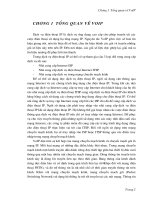TỔNG QUAN VỀ Hot stove lò sấy
Bạn đang xem bản rút gọn của tài liệu. Xem và tải ngay bản đầy đủ của tài liệu tại đây (4.49 MB, 30 trang )
HOT BLAST SOVE
I. INTRODUCTION
Evolution of hot stove
The first heat exchanger worked at 1828 in USA with pipe type, use coal as fuel. Hot blast can only be heated up to
o
315 C
From now on then, heat exchanger continuously was developed
We can classify:
Continuous type :
Pipe type, plate pipe
discrete type: Hot blast stove
I. INTRODUCTION
Purpose of hot stove in blast furnace plant
To supply hot blast to blast furnace
High hot blast temperatures are essential as they reduce the furnace’s coke requirement substantially
To facilitate the injection of auxiliary fuels such as pulverized coal as a replacement for expensive
metallurgical coke.
Significant effect in terms of reducing the cost of hot metal.
I. INTRODUCTION
Hot stove’s types
I. OPERATION OF HOT STOVE
Fuel of hot stove
Hot stove use the blast furnace gas, coke oven gas and air to burn together.
The hot gas with high temperature will be mix with cold air to control temperature before it go to blast furnace
To keep the hot gas continuously supplies to blast furnace, we need at less two hot stoves
I. OPERATION OF HOT STOVE
Operation
On- gas
On- blast
II.STRUCTURE
STRUCTURE OF DME TYPE
TWO CHAMBER
BURNER
DOME
REFRACTORY
CHECKER BRICK
CAST IRON GRID
HYDRAULIC TANK
II.STRUCTURE
TWO CHAMBER
Combustion
chamber
Combustion chamber
Place to burn fuel
Checker chember
having checker brick
for absord, release,
store heat.
checker
chamber
II.STRUCTURE
BURNER
Burner have two hole, one for fuel
(BFG + COG), one for air
Ceramic burner make by refractory, brick grade
HA65/S65KB
Fuel and air will be mixed inside ceramic burner
and burned in top of burner(outside ceramic
burner
BFG+COG
AIR
II.STRUCTURE
DOME FOR HOT STOVE
II.STRUCTURE
REFRACTORY FOR HOT STOVE
Different temperature working area we
item
will be installed different material of
position
Refractory and checker brick
45%
4
burner
1
refractory.
Al2O3
75%
To avoid thermal shock
5
2
3
3
6
4
7
8
Hot blast outlet
Upper part
Dome
5
Upper part
2
Al2O3
95.5%
Silica
95.5%
Silica
95.5%
Silica
6
45%
Upper and middle
9
1
7
middle
8
9
Middle and bottom
bottom
Al2O3
42%
fireclay
40%
fireclay
35%
II.STRUCTURE
CHECKER BRICK
Having 5 layers of checker
SL93/GW Silicon brick
brick within checker chamber
brick material
HA45/305 High alumina
FC40/315 Fire clay
FC40/325 Fire clay
FC35/330 Fire clay
FC40/315
Different temp have different
FC35/330 FC40/325 HA45/305 SL93/GW
•
II.STRUCTURE
CAST IRON GRID
To support checker
chamber, make by
cast iron.
III.PREAHEATING EXCHANGER
HYDRAULIC SYSTEM
To support combustion
chamber. During hot
stove operation, its
always happen expansion,
oil tank will control
automatic amount of oil
to support combustion
chamber.
III.PREAHEATING EXCHANGER (HEAT RECOVERY
SYSTEM)
Purpose of heat recovery system:
Used for purpose of save energy by means of utilization of low calorific combustion gas (BFG) and waste
gas (for preheating the combustion gas).
Increase combustion efficiency for hot stove.
Help the hot blast temperature to reach approx. 1250~13000C without enrichment gas.
Control the inlet temperature of chimney.
III.PREAHEATING EXCHANGER
III.1. The heat recovery system with heat carrier medium (using Oil)
III.1. The heat recovery system with heat carrier medium (using
Oil)
Advantages
Control the temperature of
Preheat combustion gas and air
Inlet chimney
Through this oil service station
Disadvantages
Very complicated due to the addition of oil service station (pumps, discharge tank…)
The oil is only able to operate at temperature lower than 350 0C
III.PREAHEATING EXCHANGER
III.2. The heat recovery system without heat carrier medium
III.2. The heat recovery system without heat carrier medium
Advantages
Very simple when we don’t need to use the oil service station
The hot blast temperature control is simpler by bypass valve
Disadvantages
Cost for piping increase.
The inlet temperature of chimney is slightly higher than the system with heat carrier medium.
III.PREAHEATING EXCHANGER
III.3. The heat recovery and preheating system
III.3. The heat recovery and preheating system
Advantages
Optimize save energy by combining the heat recovery and preheating system.
Not restricted in preheating capacity of system to the temperature limitation.
Disadvantage
Add more cost for installation of gas fire heat exchanger.
IV.
OPERATION MODE
The stove system can operate in two different modes:
Cyclic mode
Parallel mode
with N = 2, the system only can operate with cyclic mode
With N > 2, the system can operate with either cyclic mode or parallel mode
IV.OPERATION MODE
General formula
θ = θh + Δθ + θc = N x ( θc – rθc)
θc(N- N*r -1) = θh + Δθ
•
•
θ:
period blast
Δθ: HS changing time
•
θh : on gas time
•
θc : on blast time
•
•
r:
overlap factor
N: amount of HS
IV.OPERATION MODE
Cyclic mode
The cyclic mode with one stove on blast and the
remaining stove being reheated
Formula: θh+Δθ = 2θc
With r =0, N = 3
IV.OPERATION MODE
Parallel mode
The parallel mode with two stove on
blast at different temperature and
two stove be reheated.
Formula: θh+Δθ = θc
with N =4, r = 0.5)









